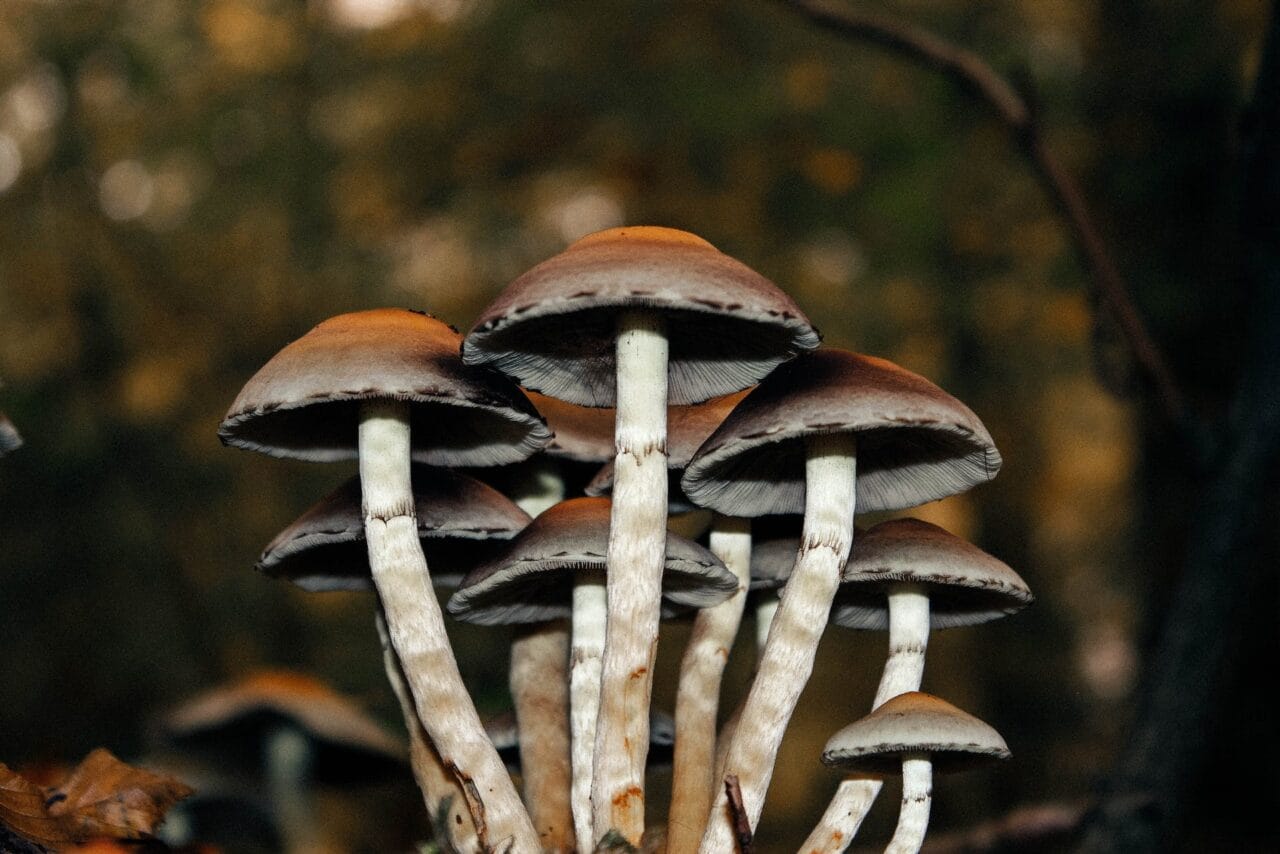Psilocybin, a psychoactive compound found in magic mushrooms, is commonly used recreationally to produce a sense of euphoria and induce hallucinations.
Beyond its mind-altering effects, research has been conducted into the compound’s potential benefits for alleviating chronic pain.
This article presents a case study on how microdosing mushrooms can potentially provide relief from chronic pain.
Key Highlights:
- Microdosing mushrooms could offer both immediate and sustained pain relief.
- Psilocybin microdosing often exhibits fewer side effects compared to traditional pain medications when used in small doses.
- Psilocybin interacts with the serotonin 2A (5-HT2A) receptors to help alleviate pain, among other conditions.

The Study
Dr. Matthew Lyes and his team from the Division of Pain Medicine in the Department of Anesthesiology at the University of California, San Diego, conducted a study titled “Microdosing Psilocybin for Chronic Pain: A Case Series“. The research focused on three patients who self-administered small doses of psilocybin to manage their chronic pain symptoms.
Three Patients, One Result – Chronic Pain Relief
Patient # 1
| AGE/ GENDER: | 37 Male |
| TYPE OF PAIN: | Neuropathic pain appearing below the area of a spinal cord injury. |
| PAIN LEVEL: | Initially 4 to 5/ 10, increasing to 8/ 10 as the day progresses |
| PSILOCYBIN DOSE: | 250 mg of ground mushroom consumed for less than 6 months |
| RESULT: | Discontinued use of prescribed pain medication, reduction in muscle spasms, and improved bowel movement regularity. No signs of rebound pain or withdrawal symptoms were observed. |
| The patient reported that while his standard medications only managed to lessen the pain, psilocybin effectively eliminated it, reducing his average pain level from 5 to 0. | |
Case Study: Subject #2
| AGE/ GENDER: | 69-year-old Female |
| TYPE OF PAIN: | Complex Regional Pain Syndrome (CRPS) |
| INTENSITY OF PAIN: | Generally, it fluctuates from 5 to 7 out of 10 and amplifies during physical activity and pain spikes |
| PSILOCYBIN DOSAGE: | Regular consumption of 500 mg for a period of 7 to 10 days, followed by a break of 2 to 3 days, over one year. Dosage escalates to 750 mg to 1 gram during episodes of severe pain |
| IMPACT: | Accounts for an 80% drop in pain for 3-4 hours, slowly returning to original levels after 12 hours. Complete pain relief (90%-100%) lasts 6-8 hours, reverting back to initial levels after 18 hours. |
| The patient reports a reduced appetite without any feelings of nausea. When the dosage is increased (750 to 1000mg), the patient experiences disorientation or instability while walking. | |
Case Study: Subject # 3
| AGE/ GENDER: | 40-year-old Female |
| TYPE OF PAIN: | Lumbar radiculopathy coupled with neuropathic pain |
| INTENSITY OF PAIN: | Rates an 8 out of 10, peaking to 10 out of 10 during physical activities |
| PSILOCYBIN DOSAGE: | A 1000 mg portion from a mushroom chocolate bar every two months. |
| IMPACT: | Significant alleviation of pain without any mind-altering effects. Increased flexibility and functionality are noted. Initially, pain levels resurface over 2-4 weeks. Successive doses enhance pain management. |
| The patient does not indicate any significant physical, cognitive, or behavioural side effects. Her mood remains mostly steady. She consistently maintains her regular dosage of her SSRI for managing depression throughout the psilocybin treatment period. | |
Deciphering Pain Management via Psilocybin
Persistent somatic and visceral pain signals strengthen specific neural pathways due to peripheral and central sensitisation, resulting in chronic physical and emotional pain experiences. Psychedelics, such as psilocybin, stimulate 5-HT2A receptors, potentially recalibrating brain regions related to neuropathic conditions.
A patient reported long-lasting pain relief that extended for weeks. This suggests that by directly stimulating the 5-HT2A receptors, a central regulation of pain perception and adaptability of synapses.
Potential Side Effects: Psilocybin and Traditional Pain Relievers Compared
| PSILOCYBIN (Based on Studies) | TRADITIONAL PAIN RELIEVERS |
| Muscle spasms | Nausea |
| Decreased appetite | Stomach discomfort |
| Confusion | Headaches |
| Unsteady gait | Dependency |
| No mood changes | Drowsiness |
Potential Areas for Future Psilocybin Research
The research team has identified promising areas for future exploration, based on their examination of three individuals’ experiences.
- Small psilocybin doses could provide immediate and possibly enduring relief from neuropathic pain, without leading to physical tolerance or addiction.
- Examine the effects of different treatment approaches when combined with psilocybin. For example, patient #3 reported an increased pain-relieving effect when psilocybin was used in conjunction with physical therapy.
- As demonstrated in this case study, small psilocybin doses could offer pain relief even without psychotherapy. The researchers propose that including therapeutic guidance might boost or extend the therapeutic effects.
Study Limitations
Despite the positive results seen in patients, it’s essential to take into account the limitations acknowledged in the study.
- The limited sample size might not represent all individuals experiencing neuropathic pain adequately.
- The study did not include subjects who did not respond to psilocybin.
- There were no assessments made before and after the treatment to gauge psilocybin’s impact on mental health conditions such as depression and anxiety.
- Most of the data was self-reported by the subjects.
- The interviewer’s presence and potential bias associated with psilocybin could have influenced the participants’ responses.
- The study did not consider the potential impact of the placebo effect.
- The study did not measure the psilocybin content in each mushroom.
The Practice of Microdosing Mushrooms
In this particular study, both Patient #1 and #2 consumed a microdose of psilocybin, originating from dried mushrooms in powdered form, whereas Patient #3 combined it with chocolate. There are a variety of products specifically created for psilocybin microdosing, and we have collated a selection of these below.
Desiccated Mushrooms
Although the research did not mention the strain employed, the strain listed below serves as an excellent initiation point for novices.
- Golden Teacher: This is among the most prevalent and frequently encountered strains of magic mushrooms.
- Amazonian Cubensis: Renowned for its beginner-friendly nature, this strain may offer cognitive benefits.
- Cambodian: Utilizing Cambodian cubensis mushrooms for microdosing can boost focus, social awareness, and mood enhancement.
Microdose Capsules
- Euphoria Psychedelics – Micro Calm Capsules: This blend incorporates Ashwagandha, Reishi, CBD, Valerian root, and Psilocybin Mushrooms, all established to aid in anxiety and stress reduction.
- Ground Sounds – Microdose Capsules – Champion Lover: This intriguing blend provides three dosage alternatives: 50mg, 100mg, or 250mg of pure psilocybin paired with reishi, cacao, cordyceps, and maca.
- Kind Stranger – Brighten Capsules 250mg: These capsules feature the Golden Teacher strain, famed for promoting clear thinking, boosting creativity, and enhancing focus.
Using Psilocybin to Ease Pain
While studies into the pain alleviating attributes of mushrooms are still at a nascent stage, the accumulation of anecdotal evidence and small-scale case studies are offering promising indications.
These instances underscore the necessity for additional research into the potential advantages of psilocybin, class=”wp-block-list”>
Especially within the field of chronic pain management.
Before psilocybin was widely acknowledged as a pain reliever, the promising findings from case studies instilled hope in those enduring chronic pain.
Frequently Asked Questions
What effects can microdosing psilocybin produce?
Psilocybin primarily activates a serotonin receptor known as “5-HT2A” in the prefrontal cortex, causing two main effects:
- Stimulation of “Brain-Derived Neurotrophic Factor” (BDNF) production
- Enhanced “Glutamate” transmission
Moreover, psychedelics foster connections between brain regions that do not typically interact. This distinct connectivity is a result of psychedelics’ ability to diminish the activity of the “Default Mode Network” (DMN), which is associated with various cognitive functions, including daydreaming, self-reflection, and pondering about the past and future.
What is the most recognized benefit of microdosing mushrooms?
Microdosing may enhance mood, productivity, creativity, and focus. It’s most notably beneficial for mental health.
In November 2022, COMPASS Pathways, a mental health company, unveiled the findings of their comprehensive phase 2b trial, a randomized and double-blind study. Their research indicated that a single dose of psilocybin resulted in significant reductions in depressive symptoms compared to a placebo. Participants who received a higher dose of 25 milligrams exhibited a prolonged antidepressant response at the twelve-week follow-up.
A study featured in the Psychiatry Research Journal suggested that psilocybin is more effective than traditional antidepressant treatments.
How do you determine your dosage?
Start with a 0.1-gram dose of psilocybin mushrooms on day one. If the desired effects are not observed, you can incrementally increase your dose by 0.05 grams on subsequent microdosing days until you find your ideal level.
Individuals with prior experience with psychotropic drugs may need to increase the dosage to 0.5 grams to attain the desired effects.
What precautions should be taken before consuming mushrooms?
class=”wp-block-list”>What is the advised frequency for taking microdoses of mushrooms?
There are several recognized protocols that suggest regulated microdosing schedules for psychedelics. The primary distinction among these protocols is the number of “off” days they incorporate, which are the days you abstain from microdosing.
The most commonly advised protocols propose integrating 1-3 rest days between microdoses. This aligns with the body’s inherent tolerance mechanisms. The three protocols under consideration here are the Fadiman Protocol, the Stamets Stack, and intuitive microdosing.




